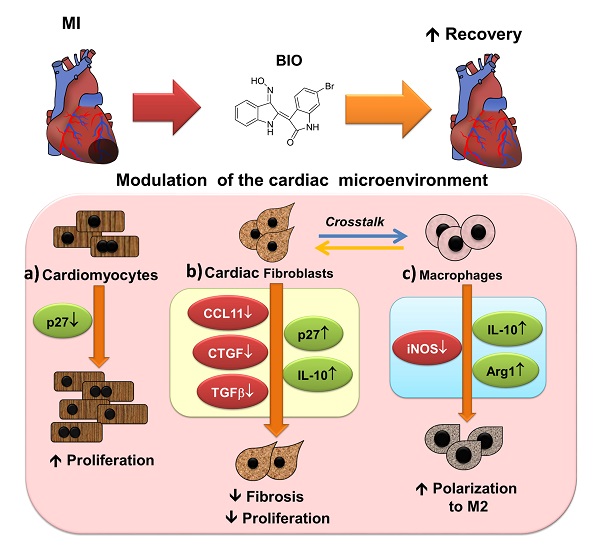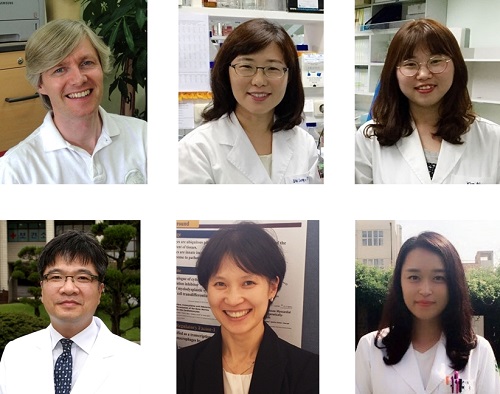Media Center
A multimedia mosaic of moments at GIST
GIST Excellence
[Press release] Professor Darren William"s research team discovers therapeutic effect of BIO (6-bromoindirubin-3"-oxime) for myocardial infarction
- 엘리스 리
- REG_DATE : 2016.08.29
- HIT : 1196
Professor Darren William"s research team discovers therapeutic effect of
BIO (6-bromoindirubin-3"-oxime) for myocardial infarction

Figures: A. photograph of Hexaplex trunculus. B. Masson’s trichrome staining of rat hearts two weeks after MI shows that 0.2 mg/kg BIO treatment reduced fibrosis and scar formation (blue staining). C. Quantification of fibrosis indicates that BIO treatment reduces scarring after MI. n = 4 in Non MI, n = 5 in MI + Veh, n = 8 in MI + BIO group, * p < 0.05, t-test.
Myocardial infarction (MI)—which is commonly known as a heart attack—occurs when cardiac muscles, consisting of interlacing strands of cardiomyocytes, are damage by prolonged ischemia. Without any clinically approved treatment options available to the medical community, the damage sustained by cardiomyocytes during myocardial infarction is usually irreversible, which results in a leading cause of death around the world.
However, Professor Darren Williams of the School of Life Sciences at the Gwangju Institute of Science and Technology (GIST) has led a research team in conjunction with the Chonnam National University Hospital to demonstrate how a BIO ((2′Z,3′E)-6-Bromoindirubin-3′-oxime), which is a compound produced by the marine gastropod Hexaplex trunculus (which also happens to be the source of the prized bromine-containing Tyrian purple dye), can modulate the post-MI cardiac environment by increasing the proliferation of cardiomyocytes and by lessening the proliferation of cardiac fibroblasts.

Schematic of the pleiotropic effects of BIO on cardiac cells to improve remodeling after MI. BIO induces proliferation in refractory cardiomyocytes, providing a therapeutic opportunity to replace a portion of the dead cardiomyocytes.
Professor William"s research team identified the mechanism of BIO as differential modulation of p27 protein expression and potent induction of anti-inflammatory interleukin-10. In the optically transparent zebrafish-based heart failure model, BIO induced cardiomyocyte proliferation and completely recovered survival rate. In a rat MI model, BIO reduced fibrosis and improved cardiac performance. Histological analysis revealed modulation of the cardiac microenvironment by BIO, with increased presence of anti-inflammatory M2 macrophages. These results demonstrate that BIO produces unique effects in the cardiac microenvironment to promote recovery post-MI.

(Clockwise from top left): Professor Darren Williams, Professor Da-Woon Jung, Ph.D. student Ah Ra Kim, Researcher Hye-Yun Jeong, Professor Yong Sook Kim, and Professor Youngkeun Ahn
Their paper entitled "Natural product derivative BIO promotes recovery after myocardial infarction via unique modulation of the cardiac microenvironment" was authored by Yong Sook Kim, Hye-yun Jeong, Ah Ra Kim, Woong-Hee Kim, Haaglim Cho, JungIn Um, Youngha Seo, Wan Seok Kang, Suk-Won Jin, Min Chul Kim, Yong-Chul Kim, Da-Woon Jung, Darren R. Williams, and Youngkeun Ahn and was published on August 11, 2016, by Scientific Reports.
Professor Williams said, "Based upon the results of our collaborative study, we expect our bench to bedside results to be readily applicable to general clinicians who wish to implement new treatment options for patients. Our future research direction will involve improving BIO"s in vivo absorption rate as well as conducting efficacy and toxicity trials in animals for drug development."